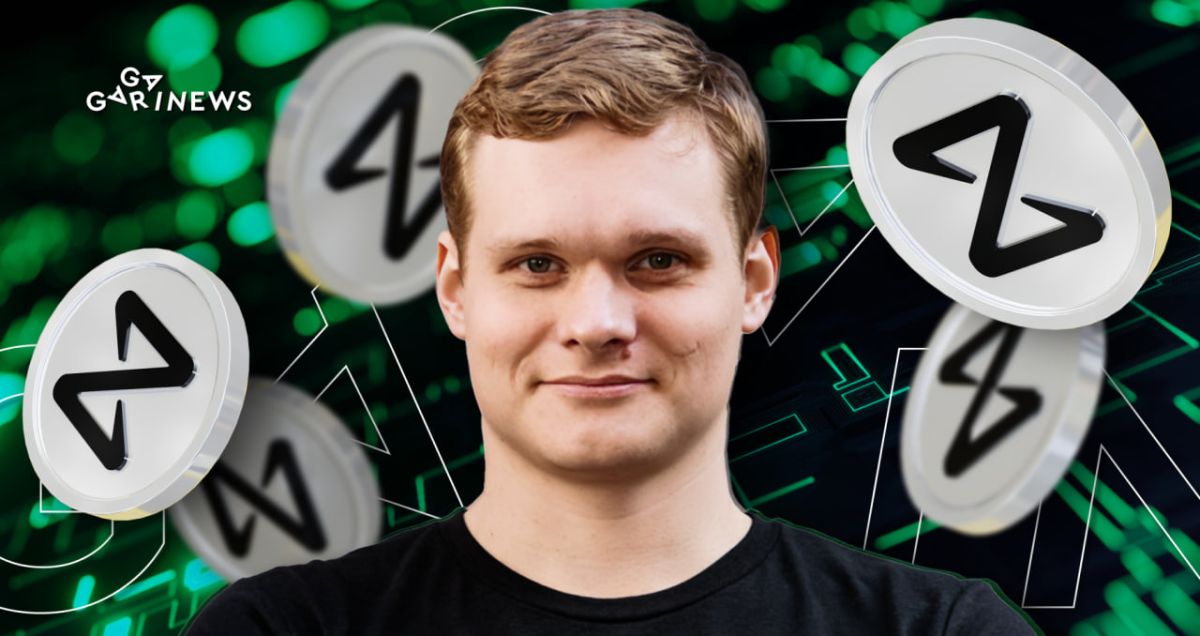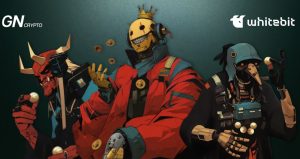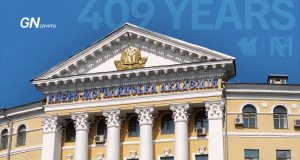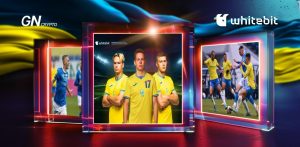An Interview with Illia Polosukhin of Near Protocol

Illia Polosukhin is the driving force behind Near Protocol, a project within the top 40 on CoinMarketCap. In this conversation, the Co-founder, CTO, and ideologist of Near unveils the internal processes of the company, shares his vision, and provides insights into blockchain, cryptocurrency, Ukraine, and much more.
On this page
GN: Illia, we’re thrilled to meet you, and thanks for finding the time for this chat. We have many questions, starting with your time at Google. Many people might know about it, but we’re curious, which part of your experience at Google do you value the most today? Any major learnings?
Illia: I would pinpoint the organization's structure as the most fascinating aspect. Google excels in numerous organizational facets but also harbors weaknesses. This experience is a continual reference as we strategize our evolution, aiming to minimize excessive bureaucracy and challenges typically found in large corporations.
GN: How did the idea of Near Protocol come about? And how closely does the current Near match what you had in mind when creating it?
Illia: We wanted to develop a crowdsourcing app and were looking into protocols and blockchains we could use. At that time, we had several hundred workers, each paid a small amount per task, and we had to handle all payments manually due to differences in payment systems across countries.
We hoped to use a single system, and blockchain seemed like a great tool for global payments. But the transaction costs on Bitcoin and Ethereum were too high compared to the sums we were paying.
We couldn’t find anything that met our needs, so we started to create our own. We brainstormed how we could make a blockchain. Initially, we had ideas about validating on mobile devices, but that didn’t really work. We went with Proof-of-Stake because we didn’t believe in the effectiveness of Proof-of-Work, and it also made it hard to achieve high blockchain speed. The main goal was scalability through sharding, with a focus on usability, simplicity, and ease of development.
These motivations are still here and are evolving into specific solutions. In the end, we tested five different consensus mechanisms, including Hashgraph, Avalanche, and our own transaction flow, before settling on our fast version of Tendermint, which we call “Doomslug.” There were many technical solutions, but our core principles have stayed the same.
GN: So, is it fair to say that the primary focus isn’t really the end-users, but more so the developers?
Illia: Well, it's actually both. We’re talking about a dual-sided market here. Both developers and users utilize the NEAR platform. But, in essence, developers, founders, and startups do take precedence, as they’re the ones defining the ultimate user experience.
GN: Can you name three features of Near that you’re particularly proud of at the moment?
Illia: First off, we're proud that we’ve built a sharding system that can handle any usage spikes. For instance, when KaiKai, currently the most popular app in Web3, launched, and another significant app on Aurora went live simultaneously, our transaction numbers skyrocketed, increasing three to four times. There was a day when we had more transactions than almost all other blockchains, Solana being the exception. And through all this, our system ran smoothly without a hitch.
Secondly, it's our account model. We aimed to design a flexible model, allowing for the creation of new accounts and enabling accounts to be transformed into contracts or DAOs or even NFTs. This simplifies the onboarding process for new users and facilitates the creation of innovative apps, which would be impossible in other systems with similar constraints. For example, if you don't have an account yet, you can convert a guest account using another key assigned to a specific account etc. Meaning this feature opens up a myriad of possibilities.
Lastly, we've introduced a hardware blockchain system this year. It facilitates decentralized front-ends, enabling quicker app development and broadening their availability across numerous portals. They're verified, modifiable, and mirror what smart contracts accomplished for web services. This innovation broadens the horizons in OpenWeb development and has allowed us to offer more to developers not working on smart contracts in Near, such as those employing other languages for Polygon, Ethereum, Optimism, and other applications—all within one integrated platform.
We're elevating the user experience, allowing users to interact with apps, oblivious to the underlying infrastructure they're utilizing. This is our ongoing direction—enhancing user-friendliness and accessibility.
GN: What are the next three challenges currently confronting Near Protocol?
Illia: We are refining the part of decentralized frontends related to the functioning of accounts across all blockchains. We have made substantial progress in creating frontends, but they still need to connect to various wallets, necessitating the transfer and signing of data. Our focus is now on developing multichain factors, which will allow users to log in and use applications across diverse networks, without having to know about the underlying blockchain variations. This is not just a feature; it’s a considerable technical challenge for our team.
Secondly, we persist in forming partnerships with applications that have substantial user bases. We've collaborated with Sweatcoin in the past, and now, Kaichain has been launched on Near. We are consistently seeking projects that are not solely interested in blockchain for launching NFTs but are looking to transform their entire business models around Web3. The integration of various applications within a single ecosystem is a significant aspect of our strategic vision and is invariably challenging.
Thirdly, we are continuing the evolution of our decentralized organization. We’ve launched what we call a dev hub, with the goal of creating a developer community that is keen on working with various chains, managing financial distributions, maintaining existing repositories, and forging new ones. This move represents a transition from developments traditionally done by specialized Labs companies to a more community-centric approach. In tandem with this, we are piloting the Near Digital Collective (NDC), our form of decentralized governance, where elected members are at the helm of decision-making processes. All these endeavors align with our aspiration to render the governance and decision-making of the system more open and equitable, emphasizing essential initiatives and valuing the input of every member of the ecosystem over the interests of any single entity or foundation. This experiment is a significant undertaking—a year dedicated to experimentation. While elections are currently in progress, I remain optimistic that our explorations and experiments in this domain will continue to expand.
GN: Are the tasks you're undertaking born out of the founders' visions, or do they originate from the DAO? How do you determine whether a certain solution is sensible and worth pursuing?
Illia: For instance, with the NDS, I was the one who introduced the idea. But it was really the community that took it and developed it further, experimenting with different approaches. I wasn’t deeply involved in its development. I simply suggested some directions, and they developed them further. Meanwhile, DevHub operates as a distinct DAO. They have their specific groups addressing subtasks, defining needed technologies, and discerning interesting ideas and community preferences.
I would say that the process is gradually transitioning to being Community Driven. My role is more about synthesizing various ideas and suggestions and serving as an advisor. Also, during our protocol infrastructure events, I can introduce potential transformative solutions for the existing system.
GN: Back in 2018, you considered Ethereum as the main competitor of Near. Five years have passed; has this perspective changed?
Illia: I wouldn't now designate them as our primary competitor… Ethereum has distinctly positioned itself as a financial hub around which all other applications revolve. We have always been more focused on the consumer market, targeting applications that cater to a wide user base—everyday people interested in earning volume points, shopping, engaging in casual games, and so forth.
Yes, other blockchains also position themselves in a similar manner. But at present, we have Sweatcoin, a top application fluctuating between the top three to five in user count depending on the week.
We also host several other growing applications. That’s where our focus lies. Ethereum is vying in the sphere of financial transactions, an area where Near isn’t the most suitable network currently. However, we do have a solid, operational bridge, and we are working on expanding the number of such bridges, striving to enhance their verification.
GN: Would it be accurate to say that Near is more versatile than Ethereum?
Illia: The concept of versatility is somewhat complex to define. In theory, one could say “anything can be done on any platform,” but the practical implications of this are not straightforward. Near predominantly operates as a consumer application designed to facilitate easy onboarding of millions of users executing millions of transactions, so economical that users hardly notice.
Yes, it is feasible to develop DeFi on Near, but currently, it lacks the sufficient liquidity to make it as seamless as it is on Ethereum. Conversely, applications that are executable on Near are not feasible on Ethereum; even Ethereum's Layer 2 cannot support them.
I would assert that our primary objective is to onboard a billion Web3 users so they can subsequently explore applications on other blockchains. In a sense, we aim to accommodate all blockchains that employ standard cryptography – including Ethereum, Bitcoin, Layer 2, Solana, etc. This approach allows applications developed on Near to conduct transactions on other chains.
The progression we envisage is the abstraction of the user from the infrastructure. The further we venture in this direction, the less consequential it becomes for users whether something is on Ethereum or Near. The prevalent concern transitions to, “I want to use this application!” We aspire to reach this state; every action we undertake is aimed at this objective, from user onboarding to structuring the requisite foundations.
GN: Revisiting your start-up journey, considering that Near began as a startup, there’s a common notion that salaries in startups tend to be lower than in established corporations. This would imply that for a programmer, opting for a start-up is a riskier endeavor. However, we often hear about startups raising substantial amounts of funds from angel investors, etc. There’s a perception that everyone suddenly has red Ferraris and Lamborghinis. How do these aspects reconcile? On one hand, there are lower salaries, but on the other, there seems to be substantial funding. How are the raised funds usually allocated, and what commitments does a startup owe to its investors?
Illia: If employees in a startup are driving Lamborghinis, it's a sign that something might have gone wrong.
Usually, startups operate as follows: they attract initial investments and assemble a core team, typically not exceeding ten members. This isn’t about securing hundreds of millions of dollars; it’s more about one to five million dollars. When the initial team members are brought onboard, their salaries are generally below market value, complemented with equity or tokens. In this scenario, they are motivated to contribute to the startup's success, not because of high immediate salaries but due to a significant stake in the potential success.
As time progresses, if the startup prospers, it expands and starts drawing in more extensive funding rounds. This is when more people are recruited, and the organization shifts from a startup to a scaleup phase. This transition also brings a change in the personnel: the original risk-takers, willing to accept lower salaries for a larger stake, are succeeded by individuals seeking higher salaries and smaller equity stakes, possibly with experience in corporate environments and process optimization within larger structures. This is the transformation that typically occurs.
In the blockchain context, it’s even more intricate due to the decentralization principle. This means, instead of having a single corporation continuing the developmental work, role distributions across subsidiaries, various organizations, DAOs, etc., occur in fundamentally different patterns, and funds are dispersed differently. Some individuals join primarily due to interest in tokens, among other varying incentives, and subsequently, they adopt diverse roles and tasks.
GN: How is the security of the protocol strategically and technically maintained, especially when developers leave the company? Is there a risk they might exploit a known vulnerability, and how is this mitigated?
Illia: That’s a good question. In an ideal scenario, the protocol shouldn’t have any known vulnerabilities, and therefore, a developer leaving shouldn’t pose a risk, as all identified vulnerabilities would be patched and resolved. However, we do maintain a bounty program. Protocol developers are excluded from participating in these bounty schemes to avoid any conflict of interest. Lastly, we have internal agreements and values; we onboard individuals driven by the mission and the challenges, not by a motive to exploit issues for personal gain.
GN: How are you navigating the current bear market? Is everything under control, and how is this downturn impacting you?
Illia: Clearly, a market decline is universally unfavorable. However, it does eliminate distractions and enables a stronger focus on creating value. We initiated our journey amidst a declining market and persisted through 2019 when the market was relatively stagnant.
GN: It must be somewhat easier now.
Illia: Indeed, it is easier now. Additionally, the ecosystem was infused with over $500 million at the onset of 2022, foreseeing market lows. This foresight has allowed for sustained ecosystem development and expansion with a focus on decentralized management structures.
GN: Do you have a ‘Plan B' in case Near falls under the scrutiny of the SEC, especially regarding cases classifying certain cryptocurrencies as unlawful securities? If such a scenario unfolds…
Illia: There are multiple facets to consider here. Firstly, the token was initiated in Switzerland, and we have a classification from FINMA, the Swiss regulatory body, declaring it a payment token. Thus, if any complications arise with U.S. regulators, we are prepared to provide all necessary documentation and information, whether it leads to a dialogue or even court, depending on the ‘how’ and ‘if’ such circumstances occur.
We are ardently focusing on ecosystem decentralization. Eventually, it will be fragmented to the extent that there won’t be a single entity to address these concerns to. We strive towards a structure that functions independently of any individual organization. Entities like Near Digital Collective and DevHub are integral components of this structure. I don’t dictate the proceedings there. They have their council, their DAO, their sub-communities, etc.
GN: What’s your take on El Salvador’s adoption of Bitcoin? Do you see such a model as scalable on a global level?
Illia: I’d argue that Bitcoin isn’t the optimal currency for this. It’s excellent for value storage, but not as a payment system.
Regarding the adoption of such technologies, I’m highly supportive, especially in Ukraine. Post-war, it's one of the most pragmatic approaches when the nation will need to rebuild, allocate subsidies and grants, and attract investments from abroad. Maintaining the confidence of foreign investors will require transparent financial management, and I see no alternative to employing a form of blockchain. Whether it’s public or private is a secondary concern, but there is a need for a cryptographic mechanism allowing for the tracking of funds and the prevention of fraudulent transactions without de-anonymizing, just confirming that you are a verified auditing entity to avoid corrupt interferences.
There are already existing tools provided by crypto. Given our historic struggle with corruption, and the potential continuation post-war, tools enabling donors to ensure that funds are directed to critical national projects are essential. I envision such adoption in Ukraine. If successful, it can be a model for countries in need like those in Africa and Argentina.
GN: If, after our interview, you’re offered the position of Minister of Digital Transformation of Ukraine, would you accept?
Illia: (laughs) Well, the current minister is quite competent; he knows everything. We, on the other hand, can provide the technology and assist in building it. I think I would be much better from a technical side than as a minister.
GN: Are you acquainted?
Illia: Yes, we are.
GN: What, in your opinion, will be the next big thing in crypto, looking at it through the lens of NFTs and all the previous trends?
Illia: That’s a tough one to forecast. I believe it’s going to be some sort of amalgamation of social elements and, still, financial tools. It might not be just DeFi but a type of tangible assets that are tokenized or a fusion with artificial intelligence. Think AI CEO, where a DAO has a CEO represented by artificial intelligence that handles execution and management, makes decisions, while the DAO acts like a board management, overseeing the DAO’s resources.
Such initiatives are fascinating because they offer a new approach to coordinate individuals, employ specialists globally, and find the best talents for various roles.
GN: Can you describe a day in your working life? What does a creator of a crypto project, ranked in the global top 40, typically do? What does this job entail?
Illia: Calls (laughs)! It involves calls, handling documents, and giving presentations. I've spent the last three weeks in Korea, Vietnam, and Singapore. I've participated in panels, conducted presentations, met with our community, managed projects, and met with people interested in Near. And in between, I've been on calls with various teams.
GN: How has the war in Ukraine affected your company’s operational abilities?
Illia: Indeed, we had a quite strong community in Ukraine. My mom and my grandparents were also there, along with several developers…
GN: Did they leave?
Illia: Some have left, some have stayed, and others have relocated to the West. In this regard, our distributed nature means people from Australia, New Zealand, Asia, Dubai, Kazakhstan, Ukraine, Poland, Czech Republic, virtually the entire Europe, as well as America and Latin America are currently contributing to the projects within our ecosystem. This level of distribution allows us a certain resilience.
Of course, it posed a moral dilemma; we had team members from both Ukraine and russia who left. It was very difficult for everyone to come to terms with what had happened…
GN: I have some quick-fire, short questions left. Ready?
Illia: Yes, let’s go.
GN: Android or iOS?
Illia: I’m using iOS now. I was an Android user before.
GN: What happened?
Illia: Good question. It’s likely due to the seamless synchronization between various devices and the utilization of a MacBook. I suppose the latter was the main reason.
GN: Satoshi Nakamoto or Vitalik Buterin?
Illia: (Laughs) More likely Vitalik.
GN: Electric vehicle or conventional vehicle?
Illia: It depends on the car. Let's go with electric vehicle.
GN: USA or Asia?
Illia: Asia.
GN: Meat or fish?
Illia: Meat.
GN: At what age did you write your first code?
Illia: First code… Probably around 10 years old.
GN: The best thing about humanity?
Illia: Society.
GN: The worst thing about humanity?
Illia: Society? (Laughs, then takes a long pause to think) Probably, selfishness.
GN: And the last question. What does a person need for happiness?
Illia: Continuous development.
GN: Thank you, Illia. I am really grateful for this interview. Best of luck to Near!
Illia: Thanks to you too, it was interesting. And I will reflect more on the worst thing about humanity.
GN: Let me know if the answer changes, I would be interested to know!
The content on The Coinomist is for informational purposes only and should not be interpreted as financial advice. While we strive to provide accurate and up-to-date information, we do not guarantee the accuracy, completeness, or reliability of any content. Neither we accept liability for any errors or omissions in the information provided or for any financial losses incurred as a result of relying on this information. Actions based on this content are at your own risk. Always do your own research and consult a professional. See our Terms, Privacy Policy, and Disclaimers for more details.

























